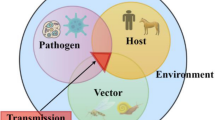Abstract
Vector-borne disease is a form of illness which is caused by parasites, viruses and bacteria. The infection is transferred through blood-feeding arthropods such as mosquitoes, fleas, ticks etc. Every year more than 700,000 deaths occur due to diseases such as yellow fever and malaria. These diseases are most common in tropical and subtropical areas and affect the underprivileged populations. Deep learning is an essential part of artificial intelligence that provides an uncanny power to systems to construct a complex network using layers of perceptrons which mimic the human neurons. This network combined with algorithms of machine learning may serve as one of the most powerful tools in healthcare to classify and analyse huge amount of medical data and predict future trends through supervised learning. This paper focused on effective prediction of vector-borne disease outbreak (multiclass classification) of three diseases (chikungunya, malaria, dengue) across the Indian subcontinent. We have examined and refined our model over data collected across India in 2013–2017. We have put forward an artificial neural network outbreak risk prediction algorithm using contrasting data. To our finest understanding, none of the previous works have centred on contrasting data in area of analysis of medical data. The prediction accuracy of our suggested ANN algorithm is 86%.
Access this chapter
Tax calculation will be finalised at checkout
Purchases are for personal use only
Similar content being viewed by others
References
K. Usha Rani: Analysis Of Heart Diseases Dataset Using Neural Network Approach.International Journal of Data Mining & Knowledge Management Process (IJDKP) Vol.1, No.5, September 2011
Shraddha Shivhare and Rajesh Shrivastava: Automatic Bone Marrow White Blood Cell Classification using Morphological Granulometric Feature of Nucleus. Oriental Journal Of Computer Science & Technology ISSN: 0974-6471 No. (1) Vol. 5 June 2012
Md. Osman Goni Nayeem, Maung Ning Wan, et al.: Prediction of Disease Level Using Multilayer Perceptron of Artificial Neural Network for Patient Monitoring International Journal of Soft Computing and Engineering (IJSCE) ISSN: 2231-2307, Volume-5 Issue-4, September 2015
Sivaranjani.R: Artificial Intelligence Model for Earlier Prediction of Cardiac Functionalities Using Multilayer Perceptron. International Conference on Physics and Photonics Processes in Nano Sciences Journal of Physics: Conference Series 1362 (2019)
Marios Anthimopoulos, Stergios Christodoulidis, et al.: Lung Pattern Classification for Interstitial Lung Diseases Using a Deep Convolutional Neural Network. IEEE Transactions On Medical Imaging, VOL. 35, NO. 5, MAY 2016
Rahib H. Abiyev and Mohammad Khaleel Sallam Ma’aitah: Deep Convolutional Neural Networks for Chest Diseases Detection. Journal of Healthcare Engineering Volume 2018
Agus Qomaruddin Munir and Edi Winarko: Classification Model Disease Risk Areas Endemicity Dengue Fever Outbreak Based Prediction Of Patients, Death, IR and CFR Using Forecasting Techniques. International Journal of Computer Applications, 2015
Juan M. Scavuzzoa, Francisco Truccoa et al.: Modeling Dengue Vector Population Using Remotely Sensed Data and Machine Learning (Preprint submitted to Acta Tropica, 2018)
B. Mahalakshmi and G. Suseendran: Prediction of Zika Virus by Multilayer Perceptron Neural Network (MLPNN) Using Cloud. International Journal of Recent Technology and Engineering (IJRTE), Volume-8, September 2019
V. Janani, N. Maadhuryaa, D. Pavithra and S. Ramya Sree: Dengue Prediction Using Multilayer Perceptron – A Machine Learning Approach. International Journal of Research in Engineering, Science and Management Volume-3, Issue-3, March-2020
Oladimeji Mudele, Fábio M. Bayer et al.: Modeling The Temporal Population Distribution Of Ae. Aegypti Mosquito Using Big Earth Observation Data (pre-print) 2019
Vijeta Sharma, Ajai Kumar et al.: Malaria Outbreak Prediction Model Using Machine Learning. International Journal of Advanced Research in Computer Engineering & Technology (IJARCET) Volume 4 Issue 12, December 2015
Prakash, K.B., Ruwali, A., Kanagachidambaresan, G.R.: Introduction to tensor flow, programming with tensor flow, EIA/Springer innovations in communication and computing. https://doi.org/10.1007/978-3-030-57077-4_1
Prakash, K.B., Ruwali, A., Kanagachidambaresan, G.R.: Introduction to tensor flow, programming with tensor Flow, EIA/Springer innovations in communication and computing. https://doi.org/10.1007/978-3-030-57077-4_1
Kanagachidambaresan, G.R., Manohar Vinoothna, G., Prakash, K.B.: Visualizations, programming with tensor flow, EIA/Springer innovations in communication and computing. https://doi.org/10.1007/978-3-030-57077-4_3
Prakash, K.B., Ruwali, A., Kanagachidambaresan, G.R.: Regression, programming with tensor flow, EIA/Springer innovations in communication and computing. https://doi.org/10.1007/978-3-030-57077-4_4
Author information
Authors and Affiliations
Editor information
Editors and Affiliations
Rights and permissions
Copyright information
© 2021 The Author(s), under exclusive license to Springer Nature Switzerland AG
About this chapter
Cite this chapter
Raizada, S., Mala, S., Shankar, A. (2021). Vector-Borne Disease Outbreak Prediction Using Machine Learning Techniques. In: Prakash, K.B., Kannan, R., Alexander, S., Kanagachidambaresan, G.R. (eds) Advanced Deep Learning for Engineers and Scientists. EAI/Springer Innovations in Communication and Computing. Springer, Cham. https://doi.org/10.1007/978-3-030-66519-7_9
Download citation
DOI: https://doi.org/10.1007/978-3-030-66519-7_9
Published:
Publisher Name: Springer, Cham
Print ISBN: 978-3-030-66518-0
Online ISBN: 978-3-030-66519-7
eBook Packages: EngineeringEngineering (R0)




